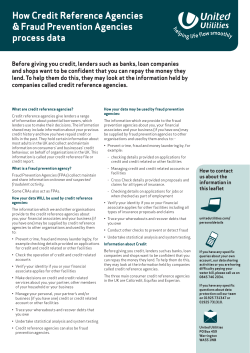
Too small to segregate duties? How to prevent fraud
Too small to segregate duties? How to prevent fraud If segregating duties is one of the primary methods to prevent employee fraud – why don’t all businesses use it? Many companies have only one to three people in their accounting department or their entire administrative staff. During annual audit engagements, they usually hear about a lack of segregation of duties – allowing one employee to collect customer payments, write and record checks, prepare bank reconciliations and then ultimately record all of these transactions. Audit clients typically respond: “My business is too small to hire additional employees to get a true segregation of duties,” or “I have had Mrs. X doing all these transactions for 10 years and have never had any problems.” Before dismissing the auditors’ comments, business owners should keep in mind that a large percentage of employee theft and embezzlement occurs in small businesses with fewer than 10 employees. And highly trusted employees employed for more than five years perpetrate a large number of these incidents, according to the 2010 Report to the Nations on Occupational Fraud and Abuse by the Association of Certified Fraud Examiners. For minimal costs, a small business owner can usually implement some procedures and controls to reduce or negate the risk of employee fraud from lack of segregation of duties. Many of these controls take little time and can be performed infrequently. Require time off. Many employee frauds are complex and time-consuming. Fraud perpetrators need to be aware of all transactions taking place every day to continue their fraud. Forcing an employee to take vacations creates a chance for the fraud to “catch up” with everyday activities. An employee may be handling collections, bad debt write-offs and bank reconciliations; recording those transactions; and perpetrating a lapping scheme. There is a greater possibility of stopping fraud if the employee isn’t there for a week to monitor this complex scheme. In one case, a 20-year trusted employee was caught per-forming a lapping scheme only because a customer complained about a bill. The person substituting for the employee realized that the customer had actually paid several weeks earlier but the customer’s account was still open. When the owner investigated further, the whole house of cards came down. Cross-train employees. Cross-training is an effective method of stopping embezzlement. It doesn’t allow one employee to perform any single accounting transaction for any length of time. Crosstraining employees can prevent complex embezzlement schemes that take place over an extended period by creating the illusion that co-workers will regularly “check” others’ work. Review monthly bank statements. Many small-business owners dismiss this simple control as too time-consuming. Actually, this procedure will take only a half hour to an hour each month, depending on the number of checks the company writes. Summarizing monthly bank activity gives the owner the opportunity to see whether anything is amiss, deposits are less than expected or vendor payments are more than anticipated. Most small-business owners are closely involved in the daily operations of their companies and can easily spot unusual checks, vendors or endorsements. The real value in this control is the appearance to employees that a control is in place that can reveal any fraud. One owner, who doesn’t have time to review the 700 to 800 checks his company writes each month, makes a big deal of going through the mail when the bank statements are delivered at the beginning of the month. He takes the unopened statements out of the mail in front of administrative employees and takes them into his office. Although he isn’t actually performing the review every month, he gives employees the illusion of a control in place. Perform background checks. This procedure is the most frequently ignored part of the employment process in small businesses. Researching applicants is well worth any costs incurred or time consumed by the owner. Background checks and screening will reveal any prior arrests, problems or bankruptcies that could become your company’s problems if the applicant is hired. A potential fraudster usually has a history with past employers. The old saying “History repeats itself” is usually true for employee theft and embezzlement. Bond and take out fraud insurance policies. A bonding company performs extensive background checks on all accounting personnel or employees who handle cash. Bonding your employees will also act as an insurance policy in case any of them do carry out a fraud and continue it over an extended period. A fraud insurance policy will also take the decision to prosecute an employee out of your hands if you are reimbursed any sustained fraud losses. The insurance company can either seek reimbursement from the employee or pursue prosecution. Many owners refuse to prosecute employees caught perpetrating a fraud because of the negative publicity for their company, or they legitimately feel sorry for the employees and their families. Institute fraud and code of ethics policies. Retrieve templates for both types of policies on the Internet. Instituting these policies demonstrates to employees that you are serious about deterring fraud. It also puts all employees on notice that your company will not tolerate fraud and will prosecute any employee caught committing fraud to the fullest extent of the law. In addition, the policies establish a set of employee guidelines regarding ethics and fraud in your company. It isn’t enough to institute the policies. You should have employees sign a copy of each policy, verifying that they have read and understood both policies fully. This procedure costs nothing to implement but sends a strong message that could be the deciding factor if an employee is thinking about committing fraud. This list of procedures and controls to prevent fraud is not all-inclusive. A highly important reminder: Employees follow the owner’s example. The tone starts at the top.
© Copyright 2025





















